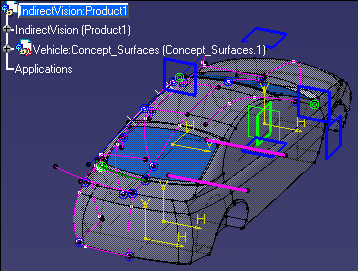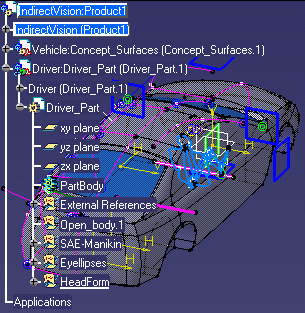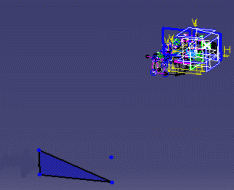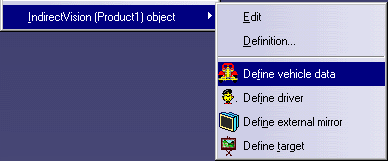 |
-
Open CATIA and close the default empty product.
|
-
From the Start menu, select RearViewMirror.
|

|
 |
If this workbench is not
available, contact your expert user for him to copy the files
provided in the Before you start topic
into the appropriate directories and to
generate the workbench enabling you to replay this scenario. |
You are now in the user workbench. All the items defined in the .CATfct
file now display in the toolbar located in the right part of the screen.
Note that the icons can be replaced with empty check boxes if no icons were
associated with the types.
-
Select the product in the specification tree and click
the  icon to
initialize the assembly context in the selected product. icon to
initialize the assembly context in the selected product.
-
Select the product and click the IndirectVision
icon. The IndirectVision type is assigned to the root product.
-
Define the type and load the vehicle.
- Right-click the IndirectVision (Product1) object in the tree
and select IndirectVision (Product1) object>Define vehicle
data. The file selection window is displayed.
|
|
|
 |
-
Instantiate the driver.
- Right-click the IndirectVision (Product1) object in the tree
and select IndirectVision (Product1) object>Define driver.
The Catalog browser is displayed.
- In the catalog browser, select Driver-2D-95-Male. The
behavior instantiates the selected driver. Click Yes
in the Save As dialog box.
|
 |
Note that if you do not have a
e:\tmp
file, you will need to edit the path in the
SaveLastPartPathUpdated.CATScript. |
 |
-
Instantiate the target.
-
Right-click the IndirectVision (Product1) object
in the tree and select IndirectVision (Product1)
object>Define target.
-
In the Catalog browser, double-click Target and
TargetTemplate. The target is instantiated.
|
|
|
 |
|
![]()
